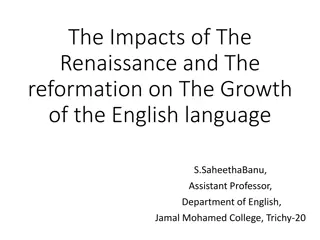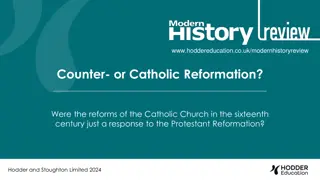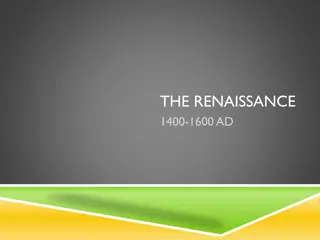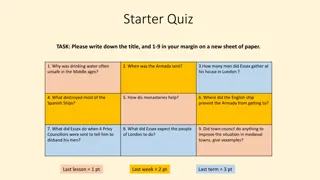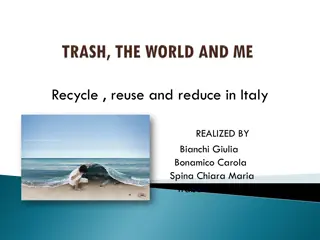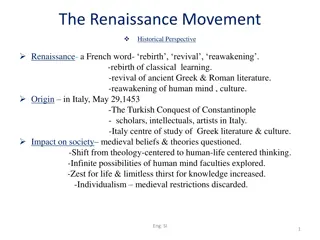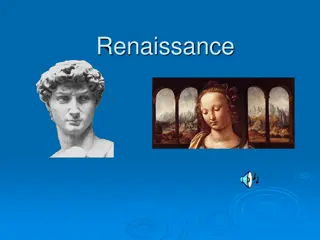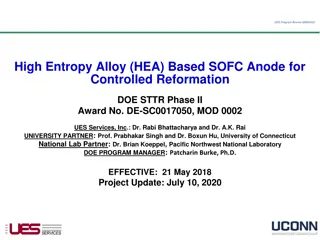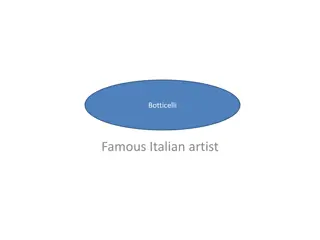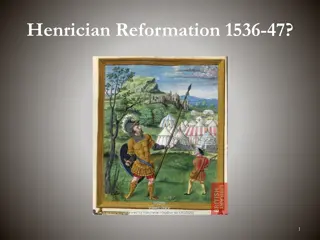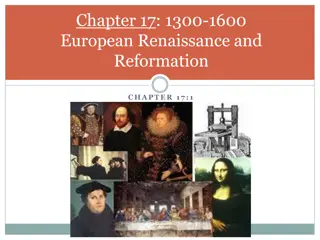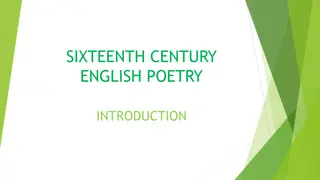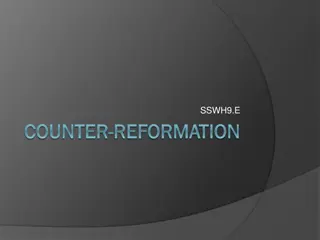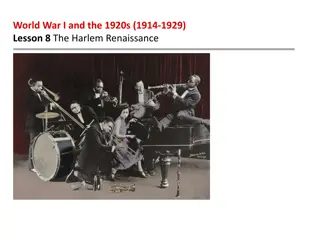The Renaissance and Reformation in Italy: A Historical Overview
The Renaissance and Reformation in Italy marked a period of rebirth and transformation between 1350 and 1550. The Italian Renaissance saw a resurgence of interest in ancient Greek and Roman cultures, characterized by urban growth, secular viewpoints, and a focus on individual ability. City-states like Milan, Venice, and Florence played crucial roles in the flourishing trade and intellectual advancements of the era. Artists and thinkers like Leonardo da Vinci and Leon Batista Alberti exemplified the spirit of innovation and creativity that defined this transformative period.
Download Presentation

Please find below an Image/Link to download the presentation.
The content on the website is provided AS IS for your information and personal use only. It may not be sold, licensed, or shared on other websites without obtaining consent from the author. Download presentation by click this link. If you encounter any issues during the download, it is possible that the publisher has removed the file from their server.
E N D
Presentation Transcript
THE RENAISSANCE Renaissance or rebirth, started in Italy between 1350 and 1550. The Italian Renaissance Italian Renaissance is a period in which a number of people who lived in Italy believed they witnessed the rebirth of the ancient Greek and Roman worlds. What are the most important characteristics of the Renaissance?
ESSENTIAL QUESTIONS What changes in society and in cities stimulated the beginning of the Renaissance? What ideas formed the foundation for the Italian Renaissance? What contributions did artists make to the Renaissance?
Renaissance Characteristics 1st- Within this growing urban society, a secular secular, or worldly, viewpoint emerged as increasing wealth created new enjoyment of material things. 2nd-the R. was an age of recovery from the disasters of the fourteenth century-the plague, political instability instability, and a decline power. The recovery went hand in hand with a rebirth of interest in ancient culture. decline of Church
3rd- The final main characteristic of the R. is the emphasis of individual ability. A high regard for human worth and a realization of what individuals could achieve created a new social ideal Leon Batista Alberti, a 15thcentury Italian, said, Men can do all things if they will. Leonardo da Vinci Leonardo da Vinci, for example was a painter, sculptor, architect, inventor, and mathematician.
THE ITALIAN STATES The lack of a single strong ruler made it possible for a number of city states in northern and central Italy to remain independent. Milan, Venice, and Florence-expanded and played crucial roles in Italian politics. The Italian city-states prospered from flourishing trade that had expanded in the Middle Ages. Italian merchants also profited from the Crusades.
MILAN Milan was one of the richest city-states in Italy. It was located in the north, at the crossroads of the main trade routes from Italian coastal cities to the Alpine passes. In the 14thcentury, members of the Visconti family established themselves as dukes of Milan. They extended their power over all of Lombardy.
MILAN The last Visconti ruler of Milan died in 1447. Francesco Sforza Francesco Sforza (SFAWRT sah) then conquered the city and became its duke. Sforza led a band of mercenaries mercenaries- soldiers who fought for the highest bidders.
VENICE Venice was another major northern Italian city- state. As a link between Asia and Western Europe, the city drew traders from all over the world. Officially Venice was a republic with an elected leader called a doge. In reality, a small group of wealthy merchant-aristocrats ran the government.
FLORENCE The republic of Florence dominated the region of Tuscany. During the 14thcentury, a small but wealthy group of merchants established control of the Florentine government. They waged a series of successful wars against their neighbors and established Florence as a major city-state.
FLORENCE AND THE MEDICI FAMILY In 1434, Cosimo The wealthy Medici family ran the government form behind the scenes. He would rule Florence until is death in 1464, where his son Piero de Medici would take over. Cosimo de Medici de Medici took control of the city. Piero would rule Florence for five years until is death and was succeeded by his son, Lorenzo.
MEDICI FAMILY Lorenzo de Medici, Lorenzo de Medici, governed from 1469 to 1492, dominated the city when Florence was the cultural center of Italy. He used his wealth to support artists, architects, and writers. As a result of Florence s prosperity and fame, Lorenzo was known as the Magnificent. Frustrated by the economic decline, the Medici family turned over the rule to to a Dominican minister.
MACHIAVELLI No one gave better expressions to the Italian s love affair with political power than Niccol Niccol Machiavelli. Machiavelli. His book The Prince is one of the most influential works on political power in the Western world. The central thesis in The Prince concerns how to acquire and keep political power. Before Machiavelli s book, many writers stressed that in order to keep political power the ruler must have Christian values. Machiavelli rejected this idea and believed that morality had little to do with politics.
THE PRINCE From Machiavelli s point of view, a prince s attitude toward power must be based on an understanding of human nature, which he believed was basically self- centered. A prince acts on behalf of the state. According to Machiavelli, for the state s sake, a leader must do good when possible but evil when necessary. Machiavelli abandoned morality as the basis for analyzing political activity and argued that the ends justify the means.
RENAISSANCE SOCIETY Although, the social order of three classes continued into the R. some changes became evident. The Nobility The Nobility Nobles, old and new dominated society by 1500s. They made up only 2 to 3 percent of the population in most countries, the nobles held important political posts and served as advisers to the king.
RENAISSANCE SOCIETY The Nobility The Nobility In The Book of the Courtier, Baldassare Castiglione described the characteristics of a perfect Renaissance noble. First First, a noble was born, not made. He was expected to have character, grace, and talent. Second Second, the perfect noble had to develop two basic skills. Military or Physical exercises and was expected to gain a classical education and enrich his life with arts. Third Third, the noble needed to follow a certain standard of conduct.
PEASANTS AND TOWNSPEOPLE In the Renaissance, they still constituted 85 to 90 percent of the total European population , except in the highly urban areas of northern Italy and Flanders. By 1500, especially in western Europe, more and more peasants became legally free. Townspeople made up the rest of the third estate.
FAMILY AND MARRIAGE The family bond was a source of great security in the dangerous urban world of Renaissance Italy. To maintain the family, parents carefully arranged marriages, often to strengthen business or family ties. Some marriages were arranged while the children were just two or three years old. The most important aspect of the marriage contract was the size of the dowry dowry, a sum of money given by the wife s family to the husband upon marriage.
FAMILY AND MARRIAGE Father-husband was the center of the Italian family. He gave it his name, managed all finances(his wife had no share in his wealth), and made the decisions that determined his children s lives. A father s authority over his children was absolute until he died or formally freed his children. In R. Italy, children did not become adults on reaching a certain age. Instead, adulthood came to children when their fathers went to a judge and freed them.
DEVELOPMENT OF HUMANISM Humanism Humanism was based on the study of the classics, the literary works of ancient Greece and Rome. Humanist studied grammar, rhetoric, poetry, moral philosophy, and history. Today these subjects are called the humanities. Petrarch Petrarch, known as the father of the Italian Renaissance humanism, did more to foster its development in the 14thcentury than any other individual.
Petrarch, Petrarch, looked for forgotten Latin manuscripts and set in motion a search for similar manuscripts in monastic libraries throughout Europe. 14thcentury humanist like Petrarch had described the intellectual life as one of solitude. They rejected family and a life of action in the community.
VERNACULAR LITERATURE The humanist emphasis on classical Latin led to its widespread use in the writings of scholars, lawyers, and theologians. However, some writers wrote in the vernacular language spoken in their own region, such as Italian, French, or German. vernacular, or the In the 14thcentury, the literary works of the Italian author Dante Dante and the English author Geoffrey Chaucer make vernacular literature more popular. Geoffrey Chaucer helped
DANTE Dante s masterpiece in the Italian vernacular is the Divine Comedy. It is the story of the soul s journey to salvation. The lengthy poem has three major sections: Hell, Purgatory, and Heaven, or Paradise. Dante is led on an imaginary journey through these three realms until he reaches Paradise, where he beholds God.
CHAUCER Chaucer used the English vernacular in his famous work The Canterbury Tales. His beauty of expression and clear language were important in making his dialect the chief ancestor of the modern English language. The Canterbury Tales consists of a collection of stories told by a group of 29 pilgrims journeying to the tomb of Thomas Becket at Canterbury England. Canterbury,
RENAISSANCE EDUCATION The humanist movement had a profound effect on education in the 1300s and 1400s. Education became increasingly secular-focused less on religion. Renaissance humanists believed that education could dramatically change human beings. They wrote books on education and opened schools based on their ideas. They wrote books on education and opened schools based on their ideas.
HUMANIST SCHOOLS At the core of humanist schools were the liberal studies. Humanists believed that liberal studies enabled individuals to reach their full potential. What were liberal studies? According to the humanists, students should study history, moral philosophy, eloquence, grammar and logic, poetry, mathematics, astronomy, and music.
HUMANIST SCHOOLS Humanist educators thought that education was a practical preparation for life. Its aim was not to create great scholars but complete citizens. Humanist education was also considered necessary for preparing the sons of aristocrats for leadership roles. Females were largely absent from these schools. The few female students who did attend humanist schools studied the classics and were encouraged to know some history, sing, ride, dance, and play a stringed instrument.
ITALIAN RENAISSANCE ART Frescoes by Masaccio are the first masterpieces of Early Renaissance (1400-1490) are. A fresco is a painting done on fresh, wet plaster with water-based paints. fresco By mastering the laws of perceptive, Masaccio could create the illusion of three dimensions, leading to a new, realistic style.
SCULPTURE AND ARCHITECTURE The Renaissance produced equally stunning advances in sculpture and architecture. The sculptor Donatello Donatello studied the statues of the Greeks and Romans. His works included a realistic, free-standing figure of Saint George.
ARCHITECTURE The work of architect Filippo Brunelleschi was inspired by the buildings of classical Rome. His design of the church of San Lorenzo in Florence reflects this. The classical columns and rounded arches in the church s design created an environment that does not overwhelm the worshipper, as Gothic cathedrals might.
HIGH RENAISSANCE MASTERS The Final stage of Italian Renaissance painting flourished between 1490 and 1520. The High Renaissance Renaissance, is the period associated with Leonardo da Vinci, Raphael, and Michelangelo . High
LEONARDO DA VINCI Leonardo mastered the art of realistic painting and even dissected human bodies to better understand their workings. However, he wanted to advance beyond such realism to create idealized forms that captured the perfection of nature and the individual-perfection that could not be expressed fully by a realistic style.
RAPHAEL By the age of 25, Raphael Italy s best painters. He was admired for his numerous madonnas (paintings of the Virgin Mary) Raphael is also known for his frescoes in the Vatican Palace. His School of Athens reveals a world balance, harmony, and order-the underlying principles of classical Greek and Roman art. Raphael was already one of
MICHELANGELO Michelangelo Michelangelo, an accomplished painter, sculptor, and architect, was another master of the High Renaissance. Fiercely driven by the his desire to create, he worked with great passion and energy on a remarkable number of projects. Michelangelo s figures on the ceiling of the Sistine Chapel in Rome depict an ideal type of human being with perfect proportion. The more beautiful the body, the more godlike the figure.
NORTHERN ARTISTIC RENAISSANCE The most important northern school of art in the 1400s was in Flanders Flanders, one of the Low Countries. The Flemish painter Jan van Eyck Jan van Eyck was among the first to use and perfect the technique of oil painting. With his oil paints, he could create striking realism in fine details as in his painting Giovanni Arnolfini and his Bride
CHRISTIAN HUMANISM During the second half of the 15thcentury, the new classical learning that was part of Italian Renaissance humanism spread to northern Europe. From that came a movement called Christian Humanism Christian Humanism, or Northern Renaissance humanism. The major goal of this movement was to reform the Catholic Church.






